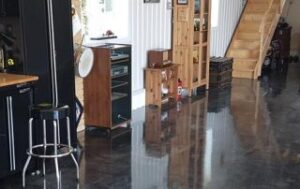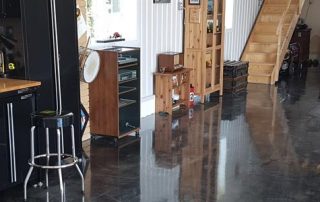an Epoxy Floor? Learn the Facts

Does your concrete flooring look dull and lifeless? If so, you may want to consider epoxy flooring. Epoxy is a type of resin that can be used to coat concrete floors and other surfaces to give them a high-gloss finish. It is also extremely durable, making it ideal for high-traffic areas.
Epoxy flooring is most commonly used in commercial settings, such as warehouses, factories, and showrooms. However, it is also becoming increasingly popular in residential homes. In this article, we’ll look at the basics of epoxy flooring before exploring the different types of epoxy available.
What is Epoxy?
Epoxy is a thermosetting plastic that consists of two main components: resin and hardener. When these two components are mixed together, they create a strong, durable bond. Once the mixture has been applied to a surface, it will need to be left to cure (harden) before it can be used.
The Advantages of Epoxy Flooring
There are many reasons why you might want to choose epoxy flooring for your home or business premises. Some of the key advantages include:
-Aesthetics: Epoxy floors can be customized to suit your individual taste. For example, you can add flakes or other decorative elements to create a unique floor design.
-Durability: Epoxy floors are extremely tough and hard-wearing. They are resistant to scratches, stains, and spills, making them ideal for high-traffic areas.
-Easy to clean: Epoxy floors are easy to keep clean and require very little maintenance.
-Safety: Epoxy floors are slip-resistant, making them safer than untreated concrete floors.
The Different Types of Epoxy Flooring
There are two main types of epoxy flooring: residential and commercial. The type of epoxy you choose will depend on the intended use of the floor.
Residential epoxy is designed for use in homes, garages, and other low-traffic areas. It is typically thinner than commercial epoxy and does not require a primer.
Commercial epoxy, on the other hand, is designed for use in high-traffic areas, such as warehouses and factories. It is much thicker than residential epoxy and usually requires a primer.
The steps involved in applying epoxy vary depending on the type of flooring you are using. However, the general process is as follows:
1. Prepare the surface: The surface must be clean, dry, and free from all dirt, dust, oil, and grease before the epoxy can be applied.
2. Mix the epoxy: The two components of the epoxy (resin and hardener) must be mixed together in the correct ratio.
3. Apply the epoxy: The mixed epoxy can now be applied to the surface using a roller, brush, or sprayer.
4. Allow the epoxy to cure: Once the epoxy has been applied, it will need to be left to cure (harden) before it can be used. This usually takes 24-48 hours.
If you’re thinking of having epoxy flooring installed in your home or business premises, it’s important to choose a reputable contractor who has experience in this type of work. Epoxy floors are a significant investment, so you’ll want to make sure they are installed correctly.
Key Differences Between Residential and Commercial Epoxy Flooring
There are several key differences between residential and commercial epoxy flooring, including:
Thickness: Commercial epoxy is much thicker than residential epoxy. This is because it needs to be able to withstand more wear and tear.
Primer: Commercial epoxy usually requires a primer, while residential epoxy does not.
Finish: Commercial epoxy floors typically have a high-gloss finish, while residential epoxy floors can have either a high-gloss or low-gloss finish.
Cost: Commercial epoxy floors are usually more expensive than residential epoxy floors.
Installation: Commercial epoxy floors must be installed by a professional, while residential epoxy floors can be installed by a DIYer.
Customization Options for Epoxy Flooring
Epoxy floors can be customized to suit your individual taste. For example, you can add flakes or other decorative elements to create a unique floor design.
If you’re looking for something truly unique, you could even have a company logo or other graphic design printed onto the floor. This is often done in commercial settings, such as showrooms and car dealerships.
Some of the most popular types of decorative epoxy flooring include:
Metallic epoxy flooring: This is a popular choice for residential and commercial settings. Metallic epoxy floors are available in a wide range of colors, including silver, gold, and copper.
Flake epoxy flooring: Flake epoxy floors are created by adding decorative flakes to the epoxy mixture. The flakes can be made from plastic, metal, or glass.
Mosaic epoxy flooring: Mosaic epoxy floors are created by adding small pieces of tile or glass to the epoxy mixture.
Printed epoxy flooring: As the name suggests, printed epoxy floors are created by printing a design onto the floor. This can be anything from a company logo to a graphic design.
Glow-in-the-dark epoxy flooring: Glow-in-the-dark epoxy floors are created by adding phosphorescent pigments to the epoxy mixture. These floors are popular in nightclubs and other entertainment venues.
Now that you know the basics of epoxy flooring, you can decide whether this type of flooring is right for your home or business premises. If you have any further questions, be sure to consult a member of our team.

